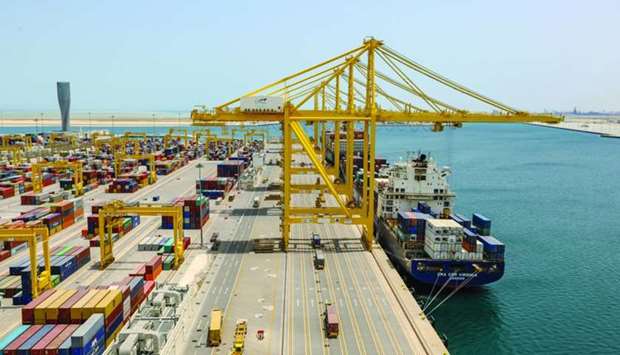Qatar’s port sector began 2021 on a stronger note with prospects appearing brighter for the country to be a regional maritime hub as transshipment volumes grew by a robust 89% year-on-year this January, according to figures of Mwani Qatar.
The general cargo movement and handling of building materials through Qatar’s Hamad, Doha and Al Ruwais ports more than tripled year-on-year in January 2021, indicating the buoyant non-oil sector and seemingly corroborating the projections of a positive overall economic momentum for the whole of this year.
The lifting of the Covid-19-related restrictions augured well for the country's maritime sector as Qatar's merchandise trade has been showing resilience; indicating Doha’s maritime sector holds promising potential for the logistics and other support services segments as well as for the special zones within the periphery.
Mwani Qatar reported transshipment volumes of 54,321 TEUs (twenty-foot equivalent units) in January this year. The government's plan is to transform Qatar into a vibrant regional trading hub in the region, given its geographical proximity with the continents and attractive regulatory, legal environment as well as robust infrastructure.
In 2019 Mwani Qatar and Swiss-based Mediterranean Shipping Company (MSC) had entered into a pact that will see Hamad Port become a regional hub for the Swiss company’s trans-shipment business.
Hamad Port will handle some 100,000 TEUs per year for MSC from 2020, with capacity growing to 1mn TEUs, which will be one-third of the second container terminal’s (CT2) overall capacity.
Hamad Port’s strategic geographical location offers opportunities to create cargo movement towards the upper Gulf, supporting countries such as Kuwait and Iraq, and south towards Oman.
The general cargo handled through the three ports stood at 188,274 tonnes in January 2021, which according to Mwani Qatar's estimates, show a 230% surge on a yearly basis. It, however, declined 18.43% month-on-month in the review period.
The container handling through the three ports stood at 137,509 TEUs (twenty-foot equivalent units), which grew 18.71% year-on-year in January 2021. On a monthly basis, the container handling was down 7.54%.
The Hamad Port, which is the largest eco-friendly project in the region and internationally recognised as one of the largest green ports in the world, alone saw 135,873 TEUs of containers handled in January 2020.
Qatar's share in the overall Middle East trade is expected to significantly increase with the robust technological infrastructure supporting the Hamad Port's CT2.
The number of ships calling on Qatar's three ports stood at 272 in January 2021, which was 6.21% and 4.9% lower on both yearly and monthly basis respectively.
"Mwani Qatar is committed to promoting Qatar’s maritime sector role and encouraging sustainable shipping practices as well as protecting the marine environment," it said recently on the World Maritime Day.
As many as 3,310 ships had called on the ports during the whole of 2020, which, however, was down 18.97% year-on-year.
Building materials handled amounted to 53,738 tonnes in January this year, which surged 222% on yearly basis and grew 27.09% month-on-month. A total of 357,493 tonnes of building materials had been handled by these three ports during the whole of 2020.
The rebound in business activities, especially in the construction sector; rather corroborates the Qatar Financial Centre’s positive outlook on the non-energy private sector.
The three ports together handled 7,160 vehicles (RORO) in January 2021, which fell 17.11% year-on-year; even as it was seen more than doubling month-on-month. Hamad Port alone handled 7,110 units, thus constituting 99% of the total in the review period.
The three ports had handled 53,738 livestock in January, which shrank 18.66% year-on-year; but witnessed more than 18% growth against that in December 2020.




